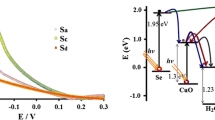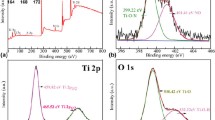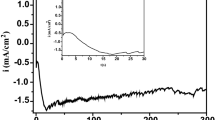Abstract
The present paper describes the use of electrodeposited Co(OH)2 on transparent conducting fluorine-doped tin oxide electrode (FTO) as functional material for ascorbic acid electrooxidation in different electrolyte solutions. The structure, composition, and morphology of film were investigated through Fourier transform infrared spectroscopy (FTIR), energy-dispersive X-ray spectrum (EDS), and scanning electron microscope (SEM). The electrochemical characterization in different electrolyte solutions was carried out by cyclic voltammetry (CV) and chronoamperometry. The voltammetric profile showed the presence of two possible reactions involving almost reversible redox processes during sweeping potential in KOH solution and a single redox process in KCl solution. The Co(OH)2 film presented electrocatalytic activity in ascorbic acid electrooxidation, being the sensitivity values found were 182.3 mA L mol−1 cm−2 and 119.4 mA L mol−1 cm−2 in KOH and KCl solutions, respectively. The results showed that the electrolytic solution strongly influenced the sensitivity of the FTO/Co(OH)2 film in ascorbic acid electrooxidation reaction. Kinetic studies showed that the electrode process was controlled by mass diffusion. In addition, chronoamperometric technique was carried out to verify the stability of the electrode. The obtained results reveal a good stability of electrode in the KCl solution; once in current density terms, the results are quite similar.









Similar content being viewed by others
References
Zare HR, Rajabzadeh N, Nasirizadeh N, Ardakani MM (2006) Voltammetric studies of an oracet blue modified glassy carbon electrode and its application for the simultaneous determination of dopamine, ascorbic acid and uric acid. J Electroanal Chem 589:60–69
Arrigoni O, De Tullio MC (2002) Ascorbic acid: much more than just an antioxidant. Biochim Biophys Acta 1569:1–9
O’Connell PJ, Gormally C, Pravda M, Guilbault GG (2001) Development of an amperometric l-ascorbic acid (vitamin C) sensor based on electropolymerised aniline for pharmaceutical and food analysis. Anal Chim Acta 431:239–247
Pinnel SR, Murad S, Darr D (1987) Induction of collagen synthesis by ascorbic acid. A possible mechanism. Arch Dermatol 123:1684–1886
Hussain MZ, Ghani QP, Hunt TK (1989) Inhibition of prolyl hydroxylase by poly(ADP-ribose) and phosphoribosyl-AMP. Possible role of ADP-ribosylation in intracellular prolyl hydroxylase regulation. J Biol Chem 264:7850–7855
Taylor TV, Rimmer S, Day B, Butccher J, Dymock IW (1974) Ascorbic acid supplementation in the treatment of pressure-sores. Lancet 2:544–546
Barbul A (1990) Immune aspects of wound repair. Clin Plast Surg 17:433–442
Akyilmaz E, Dinckaya E (1999) A new enzyme electrode based on ascorbate oxidase immobilized in gelatin for specific determination of l-ascorbic acid. Talanta 50:87–93
Suntornsuk L, Gritsanapun W, Nilkamhank S, Paochom A (2002) Quantitation of vitamin C content in herbal juice using direct titration. J Pharm Biomed Anal 28:849–855
Wu X, Diao Y, Sun C, Yang J, Wang Y, Sun S (2003) Fluorimetric determination of ascorbic acid with o-phenylenediamine. Talanta 59:95–99
Koncki R, Lenarczuk T, Adomska A, Glab S (2001) Optical biosensors based on Prussian Blue films. Analyst 126:1080–1085
Harraz FA, Faisal M, Ismail AA, Al-Sayari SA, Al-Salami AE, Al-Hajry A, Al-Assiri MS (2019) TiO2/reduced graphene oxide nanocomposite as efficient ascorbic acid amperometric sensor. J Electroanal Chem 832:225–232
Ejaz A, Jeon S (2017) A highly stable and sensitive GO-XDA-Mn2O3 electrochemical sensor for simultaneous electrooxidation of paracetamol and ascorbic acid. Electrochim Acta 245:742–751
Harraz FA, Faisal M, Al-Salami AE, El-Toni AM, Almadiy AA, Al-Sayari SA, Al-Assiri MS (2019) Silver nanoparticles decorated stain-etched mesoporous silicon for sensitive, selective detection of ascorbic acid. Mater Lett 234:96–100
Ghanbari K, Hajian A (2017) Electrochemical characterization of Au/ZnO/PPy/RGO nanocomposite and its application for simultaneous determination of ascorbic acid, epinephrine, and uric acid. J Electroanal Chem 801:466–479
Selvarajan S, Suganthi A, Rajarajan M (2017) A facile approach to synthesis of mesoporous SnO2/chitosan nanocomposite modified electrode for simultaneous determination of ascorbic acid, dopamine and uric acid. Surf Interfaces 7:146–156
Zhao S, Wang Y, Dong J, He C-T, Yin H, An P, Zhao K, Zhang X, Gao C, Zhang L, Lv J, Wang J, Zhang J, Khattak AM, Khan NA, Wei Z, Zhang J, Liu S, Zhao H, Tang Z (2016) Ultrathin metal–organic framework nanosheets for electrocatalytic oxygen evolution. Nat Energy 1:16184
Yin H, Tang Z (2016) Ultrathin two-dimensional layered metal hydroxides: an emerging platform for advanced catalysis, energy conversion and storage. Chem Soc Rev 45:4873–4891
Yin H, Zhao S, Zhao K, Muqsit A, Tang H, Chang L, Zhao H, Gao Y, Tang Z (2015) Ultrathin platinum nanowires grown on single-layered nickel hydroxide with high hydrogen evolution activity. Nat Commun 6:6430
Yin H, Tang H, Wang D, Gao Y, Tang Z (2012) Facile synthesis of surfactant-free Au cluster/graphene hybrids for high-performance oxygen reduction reaction. ACS Nano 6(9):8288–8297
Zhao S, Yin H, Du L, He L, Zhao K, Chang L, Yin G, Zhao H, Liu S, Tang Z (2014) Carbonized nanoscale metal–organic frameworks as high performance electrocatalyst for oxygen reduction reaction. ACS Nano 8(12):12660–12668
Houshmand M, Jabbari A, Heli H, Hajjizadeh M, Moosavi-Movahedi AA (2008) Electrocatalytic oxidation of aspirin and acetaminophen on a cobalt hydroxide nanoparticles modified glassy carbon electrode. J Solid State Electrochem 8:1117–1128
Karim-Nezhad G, Hasanzadeh M, Saghatforoush L, Shadjou N, Earshad S, Khalilzadeh B (2009) Kinetic study of electrocatalytic oxidation of carbohydrates on cobalt hydroxide modified glassy carbon electrode. J Braz Chem Soc 20:141–151
Jafarian M, Mahjani MG, Heli H, Gobal F, Khajehsharifi H, Hamedi MH (2003) A study of the electro-catalytic oxidation of methanol on a cobalt hydroxide modified glassy carbon electrode. Electrochim Acta 48:3423–3429
Hasanzadeh M, Karim-Nezhad G, Shadjou N, Hajjizadeh M, Khalilzadeh B, Saghatforoush L, Abnosi MH, Babaei A, Ershad S (2009) Cobalt hydroxide nanoparticles modified glassy carbon electrode as a biosensor for electrooxidation and determination of some amino acids. Anal Biochem 389:130–137
Wang Y, Zhang D, Liu H (2010) A study of the catalysis of cobalt hydroxide towards the oxygen reduction in alkaline media. J Power Source 195:3135–3139
Karim-Nezhad G, Hasanzadeh M, Saghatforoush L, Shadjou N, Khalilzadeh B, Ershad S (2009) Electro-oxidation of ascorbic acid catalyzed on cobalt hydroxide-modified glassy carbon electrode. J Serb Chem Soc 74:581–593
Maile NC, Shinde SK, Koli RR, Fulari AV, Kim DY, Fular VJ (2019) Effect of different electrolytes and deposition time on the supercapacitor properties of nanoflake-like Co(OH)2 electrodes. Ultrason Sonochem 51:49–57
Hao J, Li W, Zuo X, Zheng D, Liang X, Qiang Y, Tan B, Xiang B, Zou X (2018) Phosphate ion functionalization of Co(OH)2 nanosheets by a simple immersion method. J Alloys Compd 768:57–64
Jagadale AD, Jamadade VS, Pusawale SN, Lokhande CD (2012) Effect of scan rate on the morphology of potentiodynamically deposited β-Co(OH)2 and corresponding supercapacitive performance. Electrochim Acta 78:92–97
Vidotti M. Van Greco C, Ponzio EA, Torresi SIC (2006) Electrochem Commun 8:554–560
Brownson JRS, Lévy-Clément C (2008) Electrodeposition of α- and β-cobalt hydroxide thin films via dilute nitrate solution reduction. Phys Status Solidi 245:1785–1791
Maile NC, Koli RR, Mamlayya VB, Chougale UM, Fulari VJ (2017) Bulletin of Laser and Spectroscopy Society of India 23:63–70
Aghazadeh M, Barmi A-A M, Yousefi T (2012) Synthesis, characterization, and supercapacitive properties of β-Co(OH)2 leaf-like nanostructures. J Iran Chem Soc 9:225–229
Do J-S, Dai R-F (2009) Cobalt oxide thin film prepared by an electrochemical route for Li-ion battery. J Power Source 189:204–210
Wang SL, Qian LQ, Xu H, Lue GL, Dong WJ, Tang WH (2009) Synthesis and structural characterization of cobalt hydroxide carbonate nanorods and nanosheets. J Alloys Compd 476:739–743
Hu Z, Mo L, Feng X, Shi J, Wang Y, Me Y (2009) Synthesis and electrochemical capacitance of sheet-like cobalt hydroxide. Mater Chem Phys 114:53–57
Song D, Wang Y, Wang Q, Wang Y, Jiao L, Yuan H (2010) Effect and function mechanism of amorphous sulfur on the electrochemical properties of cobalt hydroxide electrode. J Power Source 195:7115–7119
Tabeshnia M, Rashvandavei M, Amini R, Pashaee F (2010) Electrocatalytic oxidation of some amino acids on a cobalt hydroxide nanoparticles modified glassy carbon electrode. J Electroanal Chem 647:181–186
Silva MR, Ferreira MS, Dall’Antonio LH (2012) Ascorbate electro-oxidation by modified electrodes: Polypyrrole and polypyrrole/Ni(OH)2 composite thin films. Thin Solid Films 520:6424–6428
Zhou W-J, Xu M-W, Zhao D-D, Xu C-L, Hu-Lin L (2009) Electrodeposition and characterization of ordered mesoporous cobalt hydroxide films on different substrates for supercapacitors. Microporous Mesoporous Mater 117:55–60
Saghatforoush L, Hasanzadeh M, Karim-Nezhad G, Ershad S, Shadjou N, Khalilzadeh B, Hajjizadeh M (2009) Bull Kor Chem Soc 30:1341–1348
Acknowledgements
Marcelo R. Silva would like to thank CNPQ for scholarship granted.
Funding
This work is financially supported by CNPQ (406459/2016-9), Fundação Araucária (15585/2010), and NEMAN (Pronex, 17378/2009).
Author information
Authors and Affiliations
Corresponding author
Additional information
Publisher’s note
Springer Nature remains neutral with regard to jurisdictional claims in published maps and institutional affiliations.
Rights and permissions
About this article
Cite this article
da Silva Pelissari, M.R., Archela, E., Tarley, C.R.T. et al. Ascorbic acid electrocatalytic activity in different electrolyte solutions using electrodeposited Co(OH)2. Ionics 25, 1911–1920 (2019). https://doi.org/10.1007/s11581-019-02845-5
Received:
Revised:
Accepted:
Published:
Issue Date:
DOI: https://doi.org/10.1007/s11581-019-02845-5




